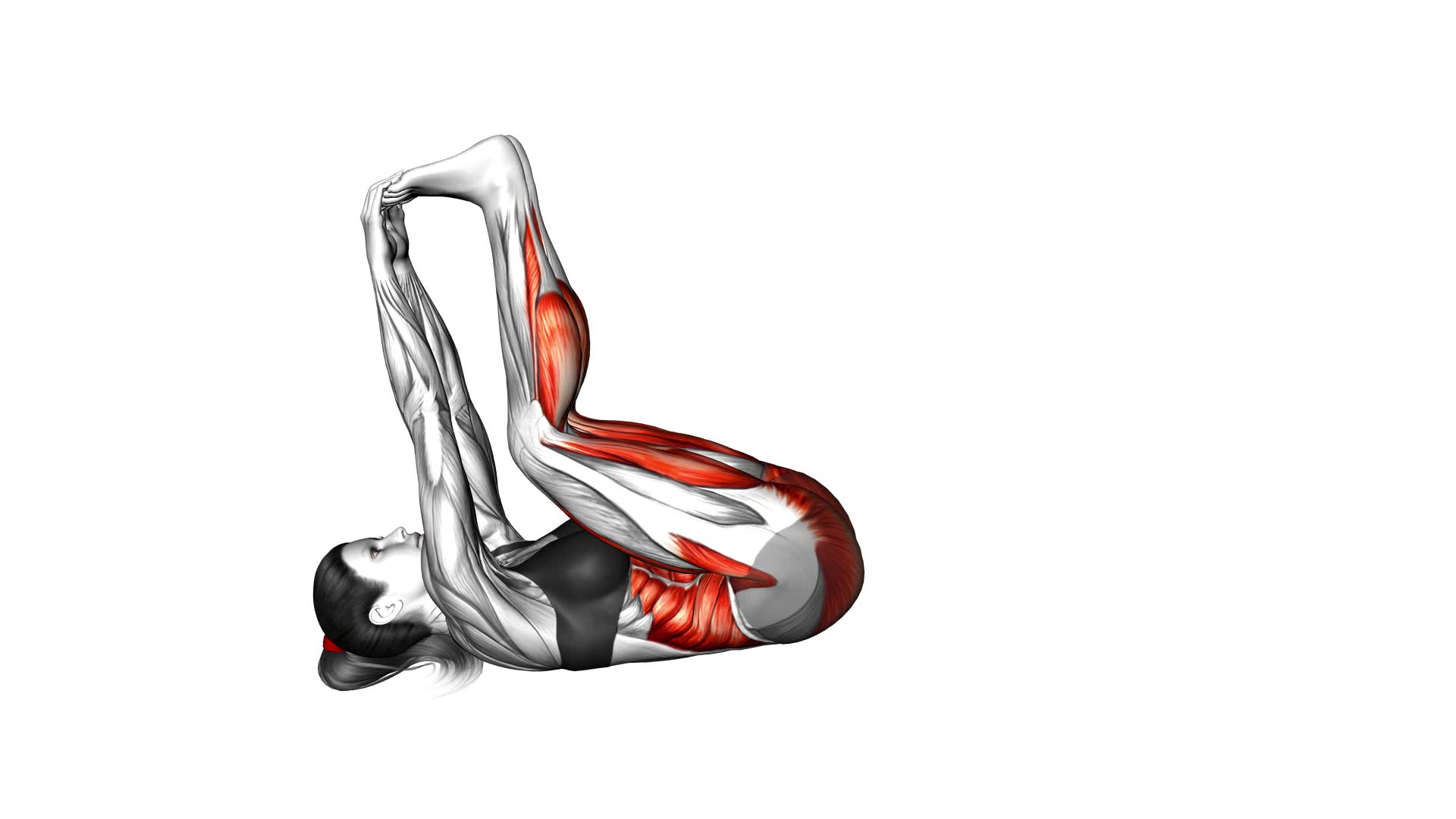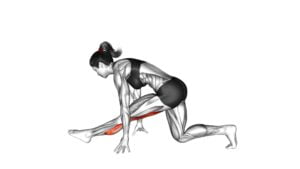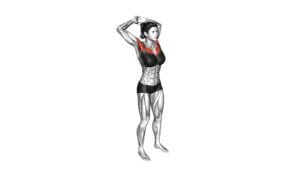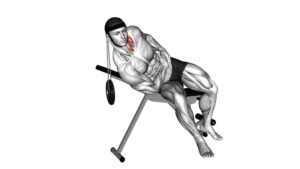Leg Over Head Calve Stretch (female) – Video Exercise Guide & Tips

Are you looking to improve your flexibility and strengthen your calves?
Watch This Exercise Video
In this article, we will guide you through the Leg Over Head Calve Stretch, a effective exercise for all fitness levels.
With proper form and technique, you can maximize the benefits of this stretch and avoid common mistakes.
Whether you're a beginner or advanced, we've got you covered with modifications and variations.
Get ready to stretch and strengthen your calves like never before!
Key Takeaways
- The Leg Over Head Calve Stretch improves flexibility in calves, ankles, and hamstrings.
- Athletes and dancers can enhance their range of motion with this stretch.
- The stretch promotes muscle relaxation and reduces soreness.
- It alleviates tightness in the lower back and hips, enhancing overall muscle function.
Benefits of the Leg Over Head Calve Stretch
To maximize the effectiveness of your Leg Over Head Calve Stretch, understanding the benefits is crucial. This stretch offers several advantages that can help improve your flexibility and promote muscle relaxation.
Flexibility improvement is one of the key benefits of the Leg Over Head Calve Stretch. By performing this stretch regularly, you can increase the range of motion in your calves, ankles, and hamstrings. This can be particularly beneficial for athletes, dancers, and individuals who engage in activities that require a high level of flexibility.
Another benefit of this stretch is muscle relaxation. As you stretch your calves and hamstrings, you release tension and tightness in these muscles. This can help reduce muscle soreness and improve overall muscle function. Additionally, the Leg Over Head Calve Stretch can help alleviate tightness in the lower back and hips, providing relief from discomfort and promoting a greater sense of relaxation.
Incorporating the Leg Over Head Calve Stretch into your exercise routine can have significant benefits for your flexibility and muscle relaxation. By dedicating a few minutes each day to this stretch, you can experience improved flexibility and a greater sense of relaxation in your lower body.
Proper Form and Technique for the Stretch
To perform the Leg Over Head Calve Stretch with proper form and technique, you'll need to follow these steps:
- Start by lying on your back with your legs extended straight out in front of you.
- Bend one knee and bring it towards your chest, then cross it over the other leg so that your foot is resting on the opposite thigh.
- Slowly lower the crossed leg towards the opposite side of your body, aiming to touch your foot to the ground beside your head.
It is important to maintain proper form and technique throughout the stretch to avoid potential injury and to maximize its effectiveness. Here are some common mistakes to avoid and tips for a more effective stretch:
- Avoid forcing the stretch by pulling on your leg or pushing your foot towards your head. Instead, let gravity do the work and allow your leg to naturally lower towards the ground.
- Keep your back flat on the floor and your shoulders relaxed. Avoid arching your back or straining your neck during the stretch.
- Breathe deeply and relax into the stretch. As you exhale, you may find that you can lower your leg a little further.
Modifications and Variations for All Fitness Levels
For modifications and variations to the Leg Over Head Calve Stretch, individuals of all fitness levels can adjust the intensity of the stretch by using props or modifying the position. These modifications allow you to customize the stretch to your specific needs and abilities.
If you're a beginner or have limited flexibility, you can use a yoga strap or towel to assist you in bringing your leg over your head. Simply loop the strap or towel around your foot and gently pull it towards your head. This will help you achieve a deeper stretch without straining your muscles.
To progress the stretch and increase its intensity, you can try modifying the position. Instead of lying on your back, you can perform the stretch in a standing position. Start by placing one foot on a raised surface, such as a step or block, and then lean forward to bring your leg over your head. This variation adds more weight to the stretch and engages your core muscles for added stability.
Remember to listen to your body and only go as far as feels comfortable. It's important to gradually increase the intensity of the stretch over time to avoid injury.
Common Mistakes to Avoid During the Stretch
Avoid these mistakes during the Leg Over Head Calve Stretch to ensure proper form and prevent injury:
- Rushing the Stretch: One common mistake is rushing through the stretch without properly warming up the muscles. Take the time to warm up your body with some light cardio exercises or dynamic stretches before attempting the Leg Over Head Calve Stretch. This will help prepare your muscles for the stretch and reduce the risk of injury.
- Overstretching: Another mistake to avoid is overstretching the calf muscles. While it's important to feel a stretch, pushing beyond your limits can lead to muscle strains or tears. Gradually increase the intensity of the stretch and listen to your body's signals. If you feel any pain or discomfort, ease off the stretch.
- Neglecting Proper Alignment: Proper alignment is crucial during the Leg Over Head Calve Stretch. Avoid leaning forward or rounding your back, as this can put unnecessary strain on your spine. Keep your back straight and engage your core muscles to maintain stability. Additionally, ensure that your hips and shoulders are aligned, and your leg is positioned correctly to target the calf muscles effectively.
Tips to Maximize the Effectiveness of the Stretch
To maximize the effectiveness of the Leg Over Head Calve Stretch, focus on maintaining proper form and incorporating these tips into your routine. By following these guidelines, you can ensure that you're maximizing flexibility and getting the most out of this stretching technique.
Firstly, make sure to warm up before attempting this stretch. Engaging in a light cardiovascular activity such as jogging or jumping jacks for a few minutes will help increase blood flow to your muscles and prepare them for the stretch.
Next, be mindful of your body alignment during the stretch. Keep your back straight and your core engaged to prevent any strain on your lower back. This will also help target the stretch to your calves more effectively.
Additionally, remember to breathe deeply and relax into the stretch. Holding your breath or tensing up can hinder the effectiveness of the stretch. Focus on breathing out as you deepen into the stretch, allowing your muscles to release and increase their flexibility.
Lastly, be consistent with your stretching routine. Incorporate the Leg Over Head Calve Stretch into your regular exercise routine to see the best results. Stretching regularly will help improve your flexibility over time and prevent muscle tightness and imbalances.
Frequently Asked Questions
How Long Should I Hold the Leg Over Head Calve Stretch?
To get the most out of the leg over head calve stretch, it's important to hold the position for an adequate amount of time. The recommended duration is around 30 seconds to 1 minute. This allows your muscles to fully stretch and increase flexibility.
Beginners can modify the stretch by using a strap or towel to assist in lifting the leg.
Incorporating this stretch into your fitness routine can improve calf flexibility, increase range of motion, and prevent muscle imbalances.
Can I Do the Leg Over Head Calve Stretch if I Have a Knee Injury?
If you have a knee injury, it may not be advisable to do the leg over head calve stretch. It could put too much strain on your knee. Instead, try modifying the stretch by keeping your leg bent or using a prop for support.
Another option is to choose alternative exercises that don't put as much stress on your knee, such as seated calf stretches or standing hamstring stretches.
Always listen to your body and consult with a healthcare professional for personalized advice.
Is It Normal to Feel Discomfort or Tightness During the Stretch?
Feeling discomfort or tightness during the stretch is normal. Your muscles are being stretched and may feel a bit tense. However, it's important to listen to your body and not push through any sharp or intense pain.
If the discomfort or tightness is mild, you can try adjusting your position or taking shorter breaks between stretches. Remember to always warm up before attempting any stretching exercise and consult with a healthcare professional if you have any concerns.
Can I Perform the Leg Over Head Calve Stretch Before or After a Workout?
Performing the leg over head calf stretch before or after a workout can be beneficial.
This stretch helps loosen and lengthen the calf muscles, improving flexibility and reducing the risk of injury.
Pre-workout stretches like this one prepare your muscles for the upcoming activity, increasing blood flow and range of motion.
It's important to listen to your body and avoid overstretching.
Incorporating this stretch into your routine can help optimize your workout and enhance overall performance.
Are There Any Precautions I Should Take Before Attempting the Leg Over Head Calve Stretch?
Before attempting the leg over head calve stretch, it's important to take some precautions. Make sure you warm up your body properly to prevent injury. Avoid this stretch if you have any existing injuries or conditions that may be aggravated. Listen to your body and don't push yourself too hard.
As for the benefits, this stretch can improve flexibility in your calves and hamstrings, and also help to increase your overall range of motion.
Conclusion
Incorporating the leg over head calve stretch into your exercise routine can provide numerous benefits, including improved flexibility and reduced muscle tension.
By maintaining proper form and technique, you can maximize the effectiveness of this stretch. Remember to listen to your body and make modifications as needed, and avoid common mistakes that may hinder your progress.
With consistency and proper execution, this stretch can be beneficial for individuals of all fitness levels.

Author
Years ago, the spark of my life’s passion ignited in my mind the moment I stepped into the local gym for the first time. The inaugural bead of perspiration, the initial endeavor, the very first surge of endorphins, and a sense of pride that washed over me post-workout marked the beginning of my deep-seated interest in strength sports, fitness, and sports nutrition. This very curiosity blossomed rapidly into a profound fascination, propelling me to earn a Master’s degree in Physical Education from the Academy of Physical Education in Krakow, followed by a Sports Manager diploma from the Jagiellonian University. My journey of growth led me to gain more specialized qualifications, such as being a certified personal trainer with a focus on sports dietetics, a lifeguard, and an instructor for wellness and corrective gymnastics. Theoretical knowledge paired seamlessly with practical experience, reinforcing my belief that the transformation of individuals under my guidance was also a reflection of my personal growth. This belief holds true even today. Each day, I strive to push the boundaries and explore new realms. These realms gently elevate me to greater heights. The unique combination of passion for my field and the continuous quest for growth fuels my drive to break new ground.



